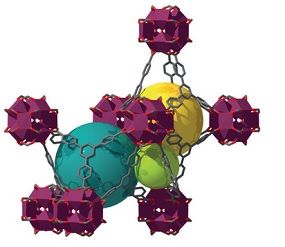Using AI to control energy for indoor agriculture
30 September 2024
Published online 22 July 2014

However, designing synthetic strategies that can produce tailor-made MOF structures with desired properties and specific topologies for target applications remains a challenging goal.
But an international team of researchers managed to use a new MOF with a novel net topology to successfully transpose and reproduce the same net in another MOF by using a different chemical system. The team, led by Mohamed Eddaoudi of King Abdullah University of Science and Technology (KAUST), Saudi Arabia, reports their findings in Nature Chemistry1.
They synthesized a new MOF called gea-MOF-1 from a newly discovered rare earth inorganic cluster, a molecular building block made by linking rare earth metal ions with 18 organic ligands.
They then used gea-MOF-1 as a blueprint to produce a new MOF with the same net topology. They replaced the rare earth cluster with metal organic polyhedra, supermolecular building blocks (SBBs) with external functional groups. Then, the team carefully designed and synthesized a specific asymmetric trefoil organic ligand, necessary for the assembly of these SBBs into the predesigned MOF structure called gea-MOF-2.
The team suggests that gea-MOF-1 can be used in methane storage, separation of hydrocarbons and as an efficient catalyst for the synthesis of cyclic carbonates from carbon dioxide, while the “gea-MOF-2 platform offers great potential as an excellent gas storage media,” says Eddaoudi.
doi:10.1038/nmiddleeast.2014.192
Stay connected: